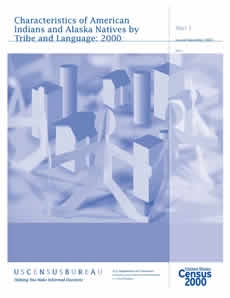Characteristics of American Indians and Alaska Natives by Tribe and Language: 2000
Characteristics of American Indians and Alaska Natives by Tribe and Language: 2000
Introduction

A two-volume report containing sample data based on both the 100-percent and sample questions for respondents who reported as American Indian or Alaska Native and specified only one American Indian or Alaska Native tribe that met a specified threshold. Sample subjects include American Indian and Alaska Native languages; family and household size; educational attainment; disability status; journey to work; income in 1999; poverty in 1999; units in structure; house heating fuel; vehicles available; value of home; telephone service available; selected monthly owner costs; and renter costs. These data are shown for the United States, regions, divisions, states, and selected metropolitan areas. This report is a companion to the Census 2000 American Indian and Alaska Native Summary File (AIANSF). It is somewhat similar to the 1990 CP-3-7, Characteristics of American Indians by Tribe and Language report.
Introduction
Data from Census 2000 are presented in three printed report series:.
- PHC-1, Summary Population and Housing Characteristics
- PHC-2, Summary Social, Economic, and Housing Characteristics
- PHC-3, Population and Housing Unit Counts
The data from Census 2000 were derived from a limited number of basic questions asked of the entire population and about every housing unit (referred to as the 100-percent questions, found on the ‘‘short form’’), and from additional questions asked of a sample of the population and housing units (referred to as the sample questions, found on the ‘‘long form’’). Appendix D presents facsimiles of the questionnaire pages used to collect the data included in this report.
The PHC-1, Summary Population and Housing Characteristics, report series provides data based on the 100-percent questions. The subjects are age, Hispanic or Latino origin, household relationship, race, sex, tenure (owner- or renter-occupied), and vacancy characteristics. Land area measurements and population density also are provided. This series is similar to the 1990 census CPH-1 series.
The PHC-2, Summary Social, Economic, and Housing Characteristics, report series provides
sample data based on both the 100-percent and the sample questions. Sample subjects include place of birth; residence in 1995; language; educational attainment and school enrollment; veteran status; disability status; employment status; journey to work; work status, earnings, income, and poverty status in 1999; physical housing characteristics; units in structure; fuel and equipment characteristics; owner and renter household characteristics, such as year owner moved into unit; home value; contract and gross rent; and mortgage and rental cost characteristics. This series is similar to the 1990 census CPH-5 series.
The PHC-3, Population and Housing Unit Counts, report series provides Census 2000 and historical comparisons of the 100-percent population and housing unit counts. It provides land and water area measurements, and population density. The user notes section documents geographic changes over the past decade. This series is similar to the 1990 census CPH-2 series.
In each series, there is one report for each state, the District of Columbia, and Puerto Rico, plus a United States summary report. Many tables in the United States summary reports include data for Puerto Rico. See Appendix E for detailed information about additional Census 2000 data products and release media.
Others in Series
Publication
Publication
Publication






